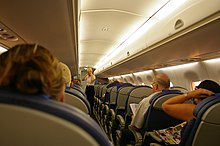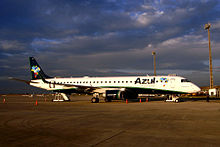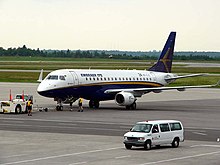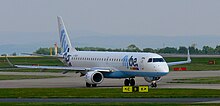Embraer E-Jet family
| E-Jet family | |
|---|---|

| |
| An Air Canada E-175 departs Montréal-Pierre Elliott Trudeau International Airport | |
| Role | Airliner |
| National origin | Brazil |
| Manufacturer | Embraer |
| First flight | February 2002 |
| Introduction | March 2004, LOT Polish Airlines |
| Primary users | Republic Airways Air Canada JetBlue Airways Compass Airlines |
| Number built | 660 (July 2010) [1][2][3] |
| Variants | Embraer Lineage 1000 |
The Embraer E-Jets are a series of narrow-body, twin-engine, medium-range, jet airliners produced by Embraer. Announced at the Paris Air Show in 1999, and entering production in 2002, the aircraft have been a success: As of June 30, 2010, there is a backlog of 227 firm orders for the E-Jets and 672 options[1][4]. The manufacturer reported that 652 units had been delivered by June 30, 2010, and predicted that by the end of 2016, more than 1,100 units would be delivered.[5]
Design and development


The Embraer E-Jets line is composed of two main commercial families and a business jet variant. The smaller E-170 and E-175 make up the base model aircraft, with the E-190 and E-195 being stretched versions, with different engines and larger wing and landing gear structures. The 170 and 175 share 95% commonality, as do the 190 and 195. The two families share near 89% commonality, with identical fuselage cross-sections and avionics, featuring the Honeywell Primus Epic EFIS suite.
Although commonly referred to with simply an "E" prefix, the jets are technically still Embraer Regional Jets ("ERJ"s).[6] Embraer dropped the ERJ prefix in its advertising early in production. The E-190/195 series of aircraft have similar capacities to the initial versions of the DC-9 and Boeing 737, which have always been considered mainline airliners. Embraer developed an innovative "double-bubble" design for its commercial passenger jet airplanes that provides stand-up headroom. Embraer E-Jets use four-abreast seating.
The launch customers for the aircraft were the French Régional Compagnie Aérienne Européenne with ten orders and five options for the E-170, and the Swiss Crossair with an order for 30 E-170s and 30 E-190s.[7] The largest single order for any type of E-Jets has come from JetBlue with 100 orders for the E-190, and options for 100 more.[8] JetBlue set the record for the longest flight of the E190 family on November 6, 2008, when aircraft N239JB made a non-stop flight from Anchorage, Alaska (ANC) to Buffalo, New York (BUF), a total of 2,694 nmi (4,989 km). This was an empty aircraft on a non-revenue flight, the aircraft eventually returning to JFK after a two-month-long charter service with Vice Presidential candidate Sarah Palin.[9]
Variants
E-170 and 175


The E-170/175 family is the smaller of the two, directly competing with the Bombardier CRJ-700/900. They also loosely compete with the turboprop Bombardier Q400. It also seeks to replace the market segment occupied by earlier competing designs such as the BAe 146 and Fokker 70. The 170 and 175 are powered with GE CF34-8E engines of 14,200 pounds (62.28 kN) thrust each.
The Embraer 170 was the first version produced. The prototype was rolled out on 29 October 2001, with first flight 119 days later on February 19. The aircraft was displayed to the public in May 2002 at the Regional Airline Association convention. After a positive response from the airline community, Embraer launched the E-175. First flight of the stretched E-175 was on June 2003 [10]. Certification for the 170 took nearly 2 years after the public debut; delivery of the first E170 aircraft to the launch customer LOT Polish Airlines was in March 2004[11]. The first E-175 was delivered to Air Canada and entered service in July 2005.[12]
E-190 and 195


The E-190/195 family is a larger stretch of the E-170/175 family fitted with a new, larger wing and a new engine, the GE CF34-10E, rated at 18,500 lb (82.30 kN). These aircraft compete with the Bombardier CRJ-1000. In addtion, being in the 100-seat range, it competes with smaller mainline jets including the Boeing 717-200, and 737-500/-600 the Airbus A318, and the upcoming Bombardier CSeries.
The first flight of the E-190 was in March 2004, with the first flight of the E-195 in December of the same year. The launch customer of the E-190 was New York-based low cost carrier JetBlue with 100 orders and 100 options. European low cost carrier Flybe launched the E-195 with 14 orders and 12 options.[13]
As the 190/195 family is of mainline aircraft size, many airlines will operate them as such, fitting them with a business class section and operating them themselves, instead of having them flown by a regional airline partner.[citation needed] For example, Air Canada operates 45 E-190 aircraft fitted with 9 business-class and 84 economy-class seats as part of their primary fleet.
Embraer Lineage 1000
On 2 May 2006, Embraer announced plans for the business jet variant of the E-190. This would have the same structure as the E-190, but with an extended range of up to 4,200 nm, and luxury seating for up to 19. The Argentine Air Force ordered one for its Presidential fleet. It was certified by the USA Federal Aviation Administration on 7 January 2009. The first two production aircraft were delivered in December 2008.
E-195X
Embraer considered producing an aircraft which was known as the E-195X, a stretched version of the E-195. It would have seated approximately 130 passengers. The E-195X was apparently a response to American Airlines' request for a replacement for their MD-80s.[14] Embraer abandoned plans for the 195X in May 2010, following concerns that its range would be too short.[15]
Operators
- Embraer 170 (or ERJ 170-100) - In July 2010 179 Embraer 170 aircraft (all variants) are in airline service, with 12 orders. Major operators include: Republic Airlines (48), Shuttle America (28), Saudi Arabian Airlines (15), EgyptAir Express (12), LOT Polish Airlines (10)[16]. About 15 airlines operate the type in smaller numbers.[17]
- Embraer 175 (or ERJ 170-200) - In July 2010, 129 Embraer 175 aircraft are in airline service, with 43 further orders. Major operators include Air Canada with 15 aircraft and LOT Polish Airlines with 12 aircraft[16]. Major firm orders include 54 aircraft for Republic Airlines and 36 aircraft for Compass Airlines (a subsidiary of Delta Air Lines).[17] Flybe, the British airline, ordered 35 Embraer 175 with options for an extra 60 and "purchase rights" for 40 more at the 2010 Farnborough airshow.[18]
- Embraer 190 (or ERJ 190-100) — In July 2010, 290 Embraer 190 aircraft (all variants) are in airline service, with 167 orders. Operators include Air Canada with 45 aircraft (with options for 60 more) and JetBlue Airways with 44 aircraft (104 firm orders) Nas Air (Saudi Arabia) (4). Other orders include 32 aircraft for US Airways.[17]
- Embraer 195 (or ERJ 190-200) — In July 2010 54 Embraer 195 aircraft (all variants) are in service and 40 firm orders. Major operators are Flybe (14), Lufthansa CityLine (14), Air Europa (5), Nas Air (2), Royal Jordanian (2). Azul Brazilian Airlines have 36 firm orders for the aircraft. [17]
Specifications
| Variant | E-170 ERJ170-100 |
E-175 ERJ170-200 |
E-190 ERJ190-100 |
E-195 ERJ190-200 |
|---|---|---|---|---|
| Flight Deck Crew | Two | |||
| Passenger Capacity (Single Class) |
80 (1-class, dense) 70 (1-class, standard) 70 (2-class, standard) |
88 (1-class, dense) 78 (1-class, standard) 78 (2-class, standard) |
114 (1-class, dense) 98 (1-class, standard) 94 (2-class, standard) |
122 (1-class, dense) 108 (1-class, standard) 106 (2-class, standard) |
| Seat pitch | 30 & 29 in (1-class, dense) 32 in (1-class, standard) 36 & 32 in (2-class, standard) |
30 in (1-class, dense) 32 in (1-class, standard) 38 & 31 in (2-class, standard) |
30 & 29 in (1-class, dense) 32 in (1-class, standard) 38 & 31 in (2-class, standard) |
31 & 30 in (1-class, dense) 32 in (1-class, standard) 38 & 31 in (2-class, standard) |
| Length | 29.90 m (98 ft 1 in) |
31.68 m (103 ft 11 in) | 36.24 m (118 ft 11 in) | 38.65 m (126 ft 10 in) |
| Wingspan | 26.00 m (85 ft 4 in) | 28.72 m (94 ft 3 in) | ||
| Height | 9.67 m (32 ft 4 in) |
10.28 m (34 ft 7 in) | ||
| Empty Weight | 21,140 kg (46,610 lb) | 21,810 kg (48,080 lb) | 28,080 kg (61,910 lb) | 28,970 kg (63,870 lb) |
| Maximum takeoff weight | 35,990 kg (79,340 lb) (STD) 37,200 kg (82,000 lb) (LR) 38,600 kg (85,100 lb) (AR) |
37,500 kg (82,700 lb) (STD) 38,790 kg (85,520 lb) (LR) 40,370 kg (89,000 lb) (AR) |
47,790 kg (105,360 lb) (STD) 50,300 kg (110,900 lb) (LR) 51,800 kg (114,200 lb) (AR) |
48,790 kg (107,560 lb) (STD) 50,790 kg (111,970 lb) (LR) 52,290 kg (115,280 lb) (AR) |
| Max payload weight | 9,100 kg (20,100 lb) (STD&LR) 9,840 kg (21,690 lb) (AR) |
10,080 kg (22,220 lb) (STD&LR) 10,360 kg (22,840 lb) (AR) |
13,080 kg (28,840 lb) | 13,650 kg (30,090 lb) |
| Takeoff Run at MTOW | 1,644 m (5,394 ft) | 2,244 m (7,362 ft) | 2,056 m (6,745 ft) | 2,179 m (7,149 ft) |
| Powerplants | 2× GE CF34-8E turbofans 62.3 kN (13,800 lbf) thrust each 63.2 kN (14,200 lbf) APR thrust each |
2× GE CF34-10E turbofans 82.3 kN (18,500 lbf) thrust each 89 kN (20,000 lbf) APR thrust each | ||
| Maximum speed | 890 km/h (481 kn, Mach 0.82) | |||
| Range | STD: 3,334 km (1,800 nmi) LR: 3,889 km (2,100 nmi) AR: 3,892 km (2,102 nmi) |
STD: 3,334 km (1,800 nmi) LR: 3,889 km (2,100 nmi) AR: 3,706 km (2,001 nmi) |
STD: 3,334 km (1,800 nmi) LR: 4,260 km (2,300 nmi) AR: 4,448 km (2,402 nmi) |
STD: 2,593 km (1,400 nmi) LR: 3,334 km (1,800 nmi) AR: 4,077 km (2,201 nmi) |
| Maximum fuel load | 9,335 kg (20,580 lb) | 12,971 kg (28,596 lb) | ||
| Service ceiling | 41,000 ft (12,500 m) | |||
| Rate of climb | Max 3,500 FPM | |||
| Thrust-to-weight | 0.42:1 | 0.39:1 | 0.41:1 | 0.39:1 |
| Fuselage and cabin cross-section | ||||
| Outer width | 3.01 m (9 ft 11 in) | |||
| Inside width | 2.74 m (9 ft 0 in) | |||
| Outer height | 3.35 m (11 ft 0 in) | |||
| Inside height | 2.00 m (6 ft 7 in) | |||
Sources: Embraer E-jet[19]
See also
Related development
Aircraft of comparable role, configuration, and era
- ACAC ARJ21
- Airbus A318
- Antonov An-148
- Boeing 717
- Boeing 737-600
- Bombardier CRJ700/900/1000
- Bombardier CSeries
- Fairchild-Dornier 728JET/928JET
- Fokker 100
- Kawasaki YPX
- Mitsubishi MRJ 70/MRJ 90
- Sukhoi Superjet 100
- Tupolev Tu-334
- Yakovlev Yak-42D
Related lists
References
- ^ a b "Embraer in Numbers" (PDF). Embraer. 2009-05-12. Retrieved 2009-05-12.
- ^ http://www.airfleets.net/exploit/production-e170.htm
- ^ http://www.airfleets.net/exploit/production-e190.htm
- ^ http://www.embraer.com.br/institucional/download/2_064-Ins-VPF-Deliveries_2Q10-I-10.pdf
- ^ Aviation Week & Space Technology, 29 October 2007 issue, p. 66.
- ^ "Embraer 170/175/190/195 Aircraft Data". Airliners.net. Retrieved 2006-07-17.
- ^ Embraer ERJ-170
- ^ "JetBlue orders 100 Embraer 190 Aircraft" (Press release). JetBlue. 2003-06-10. Retrieved 2006-07-17.
- ^ JetBlue sets world record
- ^ Embraer 170 Commercial Jetliner
- ^ 600th production E-Jet delivered to LOT
- ^ Embraer 170 Commercial Jetliner
- ^ Flybe (2007). "About our fleet". Retrieved 2008-05-23.
- ^ Kirby, Mark (2010). "Proposed stretch dubbed E-195X by Embraer". Retrieved 2010-01-26.
{{cite web}}: Unknown parameter|month=ignored (help) - ^ "Embraer kills 195X over range concerns". Flight International. 2010. Retrieved 2010-05-14.
- ^ a b LOT Polish Airlines (undated). "Fleet". Retrieved 2009-07-23.
{{cite web}}: Check date values in:|year=(help)CS1 maint: year (link) - ^ a b c d Flight International, 3-9 October 2006
- ^ "FARNBOROUGH: Flybe orders up to 140 Embraer jets". Retrieved 2010-07-21.
- ^ Embraer E-jet specifications, accessed Dec 26, 2009
